
Concept explainers
(a)
Interpretation:
The reaction between
Concept introduction:
Deuterium is an isotope of hydrogen. Deuterium contains one neutron and one proton in its nucleus while hydrogen has only one proton in its nucleus but the number of electrons in hydrogen and deuterium is one.
Isotopic substitution is a reaction in which one isotope is substituted by the other
Answer to Problem 26.34AP
The complete reaction between

Explanation of Solution
The reaction to be completed is shown below.

Figure 1
When

Figure 2
The complete reaction between
(b)
Interpretation:
The reaction between
Concept introduction:
Phenyllithium is an organometallic agent which is used to introduce metal into an organic compound during synthesis. It is used to give nucleophilic addition and substitution reactions.
Answer to Problem 26.34AP
The complete reaction between

Explanation of Solution
The reaction to be completed is shown below.

Figure 3
When indole reacts with phenyllithium, phenyllithium abstracts a proton bonded to nitrogen atom and a lithium salt of indole is formed as a conjugate base. The complete reaction is shown below.

Figure 4
The complete reaction between
(c)
Interpretation:
The reaction of
Concept introduction:
Electrophilic aromatic substitution reaction involves the substitution of an electrophile on an aromatic ring. The
Answer to Problem 26.34AP
The complete reaction of

Explanation of Solution
The reaction to be completed is shown below.
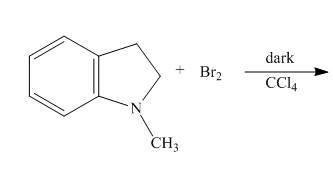
Figure 5
When
The complete reaction is shown below.

Figure 6
The complete reaction of
(d)
Interpretation:
The reaction of pyrrolizine with hydrogen in presence of platinum and carbon catalyst is to be completed by giving the major product.
Concept introduction:
Catalytic hydrogenation is a reduction process of addition of hydrogen atoms in an
Answer to Problem 26.34AP
The complete reaction of pyrrolizine with hydrogen in presence of platinum and carbon catalyst is shown below.

Explanation of Solution
The reaction to be completed is shown below.
c
Figure 7
When pyrrolizine reacts with hydrogen in presence of

Figure 8
The complete reaction of pyrrolizine with hydrogen in presence of platinum and carbon catalyst is shown in Figure 8.
(e)
Interpretation:
The reaction of
Concept introduction:
Nitration is a process in which an
Answer to Problem 26.34AP
The complete reaction of

Explanation of Solution
The reaction to be completed is shown below.
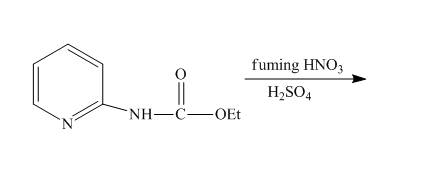
Figure 9
Nitration occurs when

Figure 10
The complete reaction of
(f)
Interpretation:
The reaction between
Concept introduction:
Electrophilic aromatic substitution reaction involves the substitution of an electrophile on an aromatic ring. The
Answer to Problem 26.34AP
The complete reaction between

Explanation of Solution
The reaction to be completed is shown below.
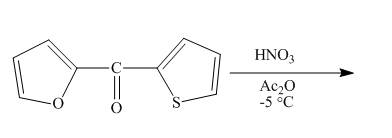
Figure 11
Electrophilic aromatic substitution reaction will occur in Furan since it is more reactive than thiophene. Therefore, nitration will occur at carbon

Figure 12
The complete reaction between
(g)
Interpretation:
The reaction of
Concept introduction:
Nitration is a process in which an aromatic compound is nitrated by electrophilic substitution mechanism in presence of concentrated sulfuric acid and concentrated nitric acid. Electron donating groups substituted on the aromatic ring are those which donates electron to the aromatic ring. Electron donating groups are ortho and para-directing.
Answer to Problem 26.34AP
The complete reaction of
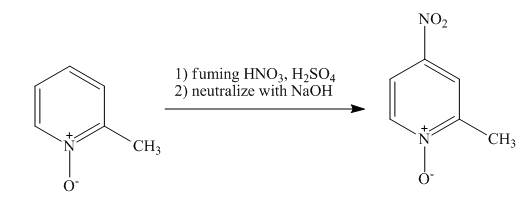
Explanation of Solution
The reaction to be completed is shown below.
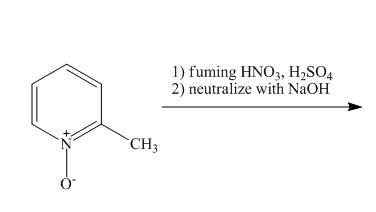
Figure 13
The pyridine ring activates towards electrophilic aromatic substitution due to the presence of pyridinium

Figure 14
The complete reaction of
(h)
Interpretation:
The reaction of
Concept introduction:
Wolff Kishner reduction is a reaction in which
Answer to Problem 26.34AP
The complete reaction of

Explanation of Solution
The reaction to be completed is shown below.
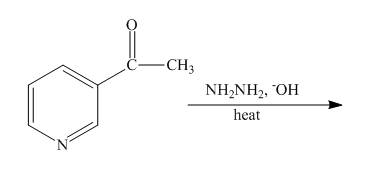
Figure 15
The Wolff-Kishner reduction takes place when

Figure 16
The complete reaction of
Want to see more full solutions like this?
Chapter 26 Solutions
Organic Chemistry, Ebook And Single-course Homework Access
- Show how to convert ethyl benzene to (a) 2,5-dichlorobenzoic acid and (b) 2,4-dichlorobenzoic acid.arrow_forwardHelp me solve this problem. Thank you in advance.arrow_forward22.7 Predict the monoalkylated products of the following reactions with benzene. (a) AlCl3 Ya (b) AlCl3 (c) H3PO4 (d) 22.8 Think-Pair-Share AICI3 The reaction below is a common electrophilic aromatic substitution. SO3 H₂SO4 SO₂H (a) Draw the reaction mechanism for this reaction using HSO,+ as the electrophile. (b) Sketch the reaction coordinate diagram, where the product is lower in energy than the starting reactant. (c) Which step in the reaction mechanism is highest in energy? Explain. (d) Which of the following reaction conditions could be used in an electrophilic aro- matic substitution with benzene to provide substituted phenyl derivatives? (i) AICI3 HNO3 H₂SO4 K2Cr2O7 (iii) H₂SO4 (iv) H₂PO₁arrow_forward
- Is an acid-base reaction the only type of reaction that would cause leavening products to rise?arrow_forwardHelp me understand this! Thank you in advance.arrow_forward22.22 For each compound, indicate which group on the ring is more strongly activating and then draw a structural formula of the major product formed by nitration of the compound. Br CHO (a) CH3 (b) (c) CHO CH3 SO₂H (d) ☑ OCHS NO₂ (e) (f) CO₂H NHCOCH3 NHCOCH, (h) CHS 22.23 The following molecules each contain two aromatic rings. (b) 000-100- H3C (a) (c) Which ring in each undergoes electrophilic aromatic substitution more readily? Draw the major product formed on nitration.arrow_forward
- V Consider this step in a radical reaction: Br: ? What type of step is this? Check all that apply. Draw the products of the step on the right-hand side of the drawing area below. If more than one set of products is possible, draw any set. Also, draw the mechanism arrows on the left-hand side of the drawing area to show how this happens. ⚫ionization termination initialization neutralization none of the abc Explanation Check 80 Ο F3 F1 F2 2 F4 01 % do5 $ 94 #3 X 5 C MacBook Air 25 F5 F6 66 ©2025 ˇ F7 29 & 7 8arrow_forwardShow how to convert ethyl benzene to (a) 2,5-dichlorobenzoic acid and (b) 2,4-dichlorobenzoic acid.arrow_forwardno aiarrow_forward
- Polymers may be composed of thousands of monomers. Draw three repeat units (trimer) of the polymer formed in this reaction. Assume there are hydrogen atoms there are hydrogen atoms on the two ends of the trimer. Ignore inorganic byproducts.arrow_forwardDraw a tetramer if this alternating copolymer pleasearrow_forwardDraw the monomers required to synthesize this condensation polymer.arrow_forward
 ChemistryChemistryISBN:9781305957404Author:Steven S. Zumdahl, Susan A. Zumdahl, Donald J. DeCostePublisher:Cengage Learning
ChemistryChemistryISBN:9781305957404Author:Steven S. Zumdahl, Susan A. Zumdahl, Donald J. DeCostePublisher:Cengage Learning ChemistryChemistryISBN:9781259911156Author:Raymond Chang Dr., Jason Overby ProfessorPublisher:McGraw-Hill Education
ChemistryChemistryISBN:9781259911156Author:Raymond Chang Dr., Jason Overby ProfessorPublisher:McGraw-Hill Education Principles of Instrumental AnalysisChemistryISBN:9781305577213Author:Douglas A. Skoog, F. James Holler, Stanley R. CrouchPublisher:Cengage Learning
Principles of Instrumental AnalysisChemistryISBN:9781305577213Author:Douglas A. Skoog, F. James Holler, Stanley R. CrouchPublisher:Cengage Learning Organic ChemistryChemistryISBN:9780078021558Author:Janice Gorzynski Smith Dr.Publisher:McGraw-Hill Education
Organic ChemistryChemistryISBN:9780078021558Author:Janice Gorzynski Smith Dr.Publisher:McGraw-Hill Education Chemistry: Principles and ReactionsChemistryISBN:9781305079373Author:William L. Masterton, Cecile N. HurleyPublisher:Cengage Learning
Chemistry: Principles and ReactionsChemistryISBN:9781305079373Author:William L. Masterton, Cecile N. HurleyPublisher:Cengage Learning Elementary Principles of Chemical Processes, Bind...ChemistryISBN:9781118431221Author:Richard M. Felder, Ronald W. Rousseau, Lisa G. BullardPublisher:WILEY
Elementary Principles of Chemical Processes, Bind...ChemistryISBN:9781118431221Author:Richard M. Felder, Ronald W. Rousseau, Lisa G. BullardPublisher:WILEY





